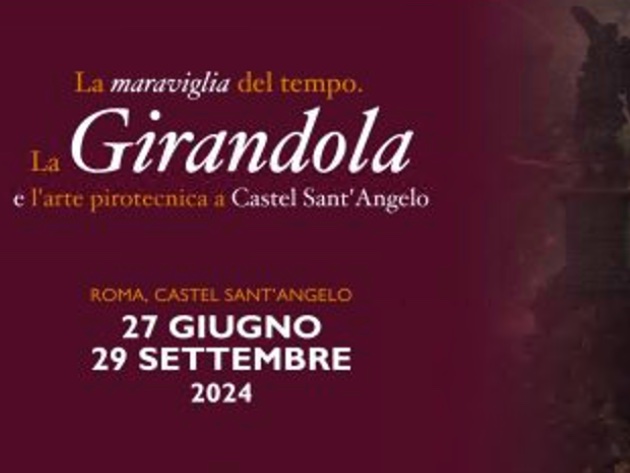
The historical-documentary exhibition The Wonder of Time. The Girandola and the pyrotechnic art in Castel Sant'Angelo hosted in the monument of the same name, conceived by Eva M. Antulov, aims to reconstruct the tradition of the Girandola, one of the grandest celebrations that took place in Rome starting from the 15th century, on various occasions throughout the year, the most famous of which was June 29th, the day dedicated to Saints Peter and Paul, patron saints of Rome.
The exhibition is divided into different rooms and presents paintings, prints, manuscripts and fire engines, up to the present day. In the first room in particular - the Hall of Apollo - the iconography of fire is illustrated in the representation of religious festivals and the miraculous apparition of the Archangel Michael, which took place, according to tradition, in 590 AD. above the Mole Adriana which, following the miraculous event which followed the end of the plague, changed its name to Castel Sant'Angelo and Ponte Elio to Ponte Sant’Angelo.
From this event the custom of transferring pyrotechnic displays to Castel to celebrate the most important religious holidays was established: in 1481 Pope Sixtus IV (1471-1484) sanctioned the tradition of the Girandola on the occasion of the tenth anniversary of his pontificate, creating a one-of-a-kind fireworks display. Since then the Pinwheel at Castel Sant'Angelo has entered the collective imagination as the "Marvel of Time", according to the definition spread by the French writer J. Jérôme L. de Lalande in his work Voyage d'un Français en Italie, fait dans les années 1765 et 1766. In this room, there are a series of prints, etchings, manuscripts, which tell the iconography of the fireworks displays between the sixteenth and seventeenth centuries, as well as the rare manuscript from the sixteenth century, theTrattato de la Pirotechnia (Treatise on Pirotechnia), which describes the mixtures used in the preparation of the fireworks.
In the Hall of Justice, the central role that the Bombers of Castel Sant'Angelo had in the preparation and carrying out of the fireworks displays is highlighted. The last sections of the exhibition occupy the two Clement VIII Rooms: in the first, paintings and prints depicting the spectacle of the Pinwheel are displayed, in particular the oil painting on canvas from 1620 by the Flemish Willem van Nieulandt II, known as Guglielmo Terranova, entitled View front of Castel Sant'Angelo with the Girandola, which depicts a spectacular night vision with fireworks; in the second Clement VIII Room, divided into two sections, the decline of the Girandola starting from the nineteenth century is explored in depth, when the ceremony, moved to the terraces of the Pincio for a few years, finally fell into oblivion. This last phase is well illustrated by a rich documentary repertoire, consisting of postcards, prints and newspaper articles.
The exhibition was created by the Pantheon and Castel Sant'Angelo institute - National Museums Directorate of the city of Rome and makes use of the scientific committee chaired by prof. Claudio Strinati, and also composed by prof. Michele Rak and Dr. Sandro Bari. It takes place under the auspices of the Presidency of the VII Permanent Commission of the Chamber of Deputies - Culture, Science and Education and benefits from the support of Enel Italia.
Photo credits: Official poster of the exhibition
Informations
Dal 27 giugno al 29 settembre 2024
dal martedì alla domenica
dalle ore 9.00 alle ore 19.30 (ultimo ingresso ore 18.30)
Chiuso il lunedì
 Condividi
Condividi











































